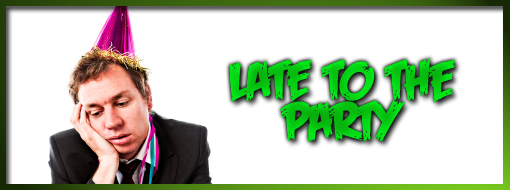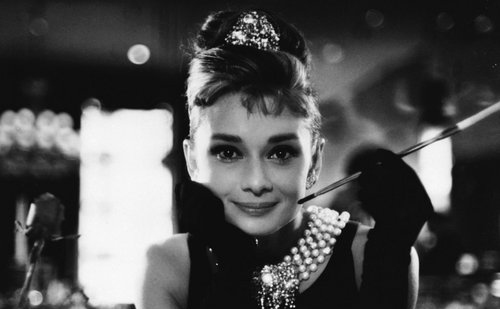Every single person who visits this site fancies themselves a film fan. From the nameless readers who don’t interact to the regular Chewers on the Boards to every single person on the staff – we love film. We live for it. We watch as much of it as we can. But, sadly, we’ll never be able to see everything. We’ve missed a lot over the years and sometimes we’ll miss one of the big ones. One of the classics or cult favorites that has had everyone talking and proclaiming their love for years. Lord knows my To-Watch List is shamefully long. So that’s what this column is all about – catching up on those Big Ones. Maybe it’ll get you to rewatch an old favorite you haven’t seen in years, maybe it’ll get you to catch up on your own list of shamefully neglected films. If nothing else, it’ll at least give you an excuse to yell at me for waiting so damn long to see something. So dig it.
I was familiar with that above image of Audrey Hepburn long before I knew who Audrey Hepburn was, or where the image even came from. It’s one of those things that sort of permeates pop-culture, ubiquitous but kind of low-key – everybody knows what it is but nobody really talks about it. And that’s kind of how it stayed for a long time. I was never really given any context to go along with the picture (though it managed to evoke a lot on its own and I tend to credit it with helping shape and set into evolution what I found appealing in a woman from a purely superficial standpoint) but I knew it was there and I came to know, to at least some degree, what it represented (or at least from where it came, at any rate). But that was that and there it sat, on my radar of curiosities, for the longest time. But it wasn’t until recently that I’d ever been given any reason to bump it up the list of priorities…
Breakfast at Tiffany’s (1961) – Buy it from CHUD
That reason, which seems kind of suspect in hindsight, is that I seemed to have picked up on a bit of backlash directed at Holly Golightly. I say it’s suspect because I can’t really remember where I heard it or what was actually said and there’s every chance that I had taken something completely out of context given that I hadn’t seen the film yet. But regardless of that, it had painted a certain picture in my head of who this Holly Golightly might be (and the synopsis calling her a “fortune hunter” certainly worked in that picture’s favor) and it just didn’t jive with the number of all SORTS of women I’ve known who’ve had this image in various frames on various walls in various rooms.
But, even so, that preconceived notion is what I took into the movie with me and I expected to sort of hate Holly. And the title sequence didn’t do her any favors either – there she was in that black dress and those giant sunglasses and all that jewelry with her hair swept up, looking longingly into the window of one of the most famously exclusive jewelry stores in the nation. Fortune hunter, indeed. The sentiment carries over as she makes her way back to her building where we find a…well, I guess we’ll call him a jilted lover, actually sleeping in his car waiting for her to come home so he can question her about why she’d left him high and dry at (what we presume to be) a restaurant. It’s that flippant way she just completely and totally dismisses him, while at the same time blowing off the understandable frustration of her upstairs neighbor (more on THAT guy later) at having been woken up to let Holly in the building because she lost her key again that really tends to cement any preconceived notion one may have brought with them. No, for all intents and purposes, at least in these first few minutes, Holly Golightly is not a good person.
But what‘s fantastic is that it‘s the very next scene that blows all of that wide open. When Holly herself is awoken by someone buzzing her to let them in, she winds up letting the visitor come in to use the phone and it’s here where we truly see Holly Golightly for the first time, in that we don’t see anything. Her apartment is sparse and very much without a personality and she essentially lives out of her suitcase (a suitcase in which she also happens to keep her telephone). Now, on the surface, that could serve to further along the opinions we made of Holly in the beginning, but we get introduced to cat the cat and the ensuing conversation between Holly and who we’ve come to know as Paul Varjack tells us everything we need to know about Holly Golightly. Namely that she’s a woman without an identity and, as such, she refuses to give anything in her life an identity. Her cat is just cat, her apartment is all function and no form and her romantic pursuits are merely…financial.
Actually, now that I mention that, there’s a brief conversation between Holly and Paul a short time later in the film where it’s subtly alluded to that the both of them exchange sex for money and the way it’s presented and treated is impressively handled, being both a snapshot of how that era viewed sex and sexuality while still being very liberated about it. Granted, there’s a lot of tiptoeing going on, for instance you can tell that it’s a rather big deal that Holly sleeps naked, but the film doesn’t go out of its way to make it a big deal, if that makes any sense. And in retrospect it’s very possibly that mandated tiptoeing that helps make the movie so rich and dynamic, as given the leeway today’s filmmakers have, Holly Golightly would be just another “hooker with a heart of gold.” And Edwards doesn’t make a point to fetishize Holly, as others would, instead he understands that these little…quirks, if you will, are all part and parcel of who Holly is (or isn’t, rather) and he never loses focus of that.
And speaking of Blake Edwards – the man directed the SHIT out of this movie. His staging and eye, grouped with Franz Planer’s cinematography and Hepburn and Peppard’s performances make this a wonderfully delightful film to experience. There’s a party scene early in the movie that seems to be commenting on the vapid superficiality that Holly has taken sanctuary in and it’s so weird and so (seemingly) out of left field, but the choreography on display between the actors and the camera is staggeringly impressive. It’s the kind of thing I’m surprised isn’t brought up more in discussions of these things. But that’s a bit of a digression…
At any rate, the movie continues on and as we learn a lot more about where Holly came from and how she ended up where she ended up, of course a tiny little romance starts to blossom between Holly and Paul (more with Paul than Holly, though) and it’s all culminated with a second-act date sequence that’s pretty much perfect, all things considered. But it’s going to take more than a perfect day-date to make Holly changer her spots and the rest of the movie is spent with the two of them trying to come to terms with each other. Or, well, Paul trying to make Holly come to terms with herself and hoping he gets brought along for the ride. That really oversimplifies it, but only in the interest of not spelling the plot out for you beat by beat. It all builds up to a cab ride in the rain and monologue by Paul that drags everything to such a grand payoff that anyone who walks away dry-eyed either hasn’t been paying attention or just doesn’t have a soul.
And to spend a little bit on the ancillary stuff – a small deal has been made about Holly Golightly being the jumpoff for the modern day “Manic Pixie Dream Girl,” and yeah – the foundation is certainly there. But the difference between her and the Zooey Deschanels of today’s cinema is that Holly Golightly isn’t an archetype – she’s a real person. She doesn’t exist to teach Paul Varjack a lesson or two about himself, she just exists, and so does he and, as such, it’s one of the most honest relationships I’ve seen in a quote-unquote romantic comedy. It probably wouldn’t be handled as deftly in today’s Hollywood. And speaking of things not being handled deftly – Mickey Rooney as Holly’s neighbor Mr. Yunioshi. No, Blake Edwards. If her interactions with him weren’t rather important to her character progression I’d be pleased as punch to watch a cut of the film with that awful, awful stuff removed.
So in a nutshell, that’s Breakfast at Tiffany’s. It’s not a perfect movie, but it’s a damn good one and the strength of Hepburn‘s performance and Edwards‘ direction elevate it to a classic. I haven’t read Capote’s novella, so I don’t know how it stacks up, but in all honestly the one area where the filmic adaptation lacks is story. The pacing’s a little weird and some of the beats don’t necessarily flow into one another and what it really feels like is a story written by someone who truly and deeply understands people, but has only a basic grasp on storytelling. But that’s okay, because when Holly finds cat in the rain and hugs him tight it’s not gonna matter.
Breakfast at Tiffany’s isn’t a perfect movie, just like Holly Golightly isn’t a perfect person. But I kinda really love them both.

